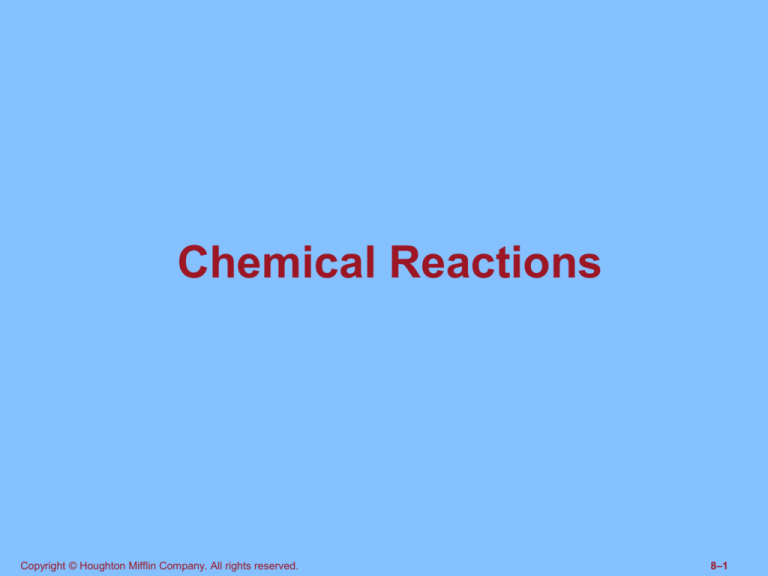
Chemical Reactions
Copyright © Houghton Mifflin Company. All rights reserved.
8–1
8.1 Types of Chemical Reactions
Simple, e.g. Precipitation
K2CrO4 (aq) + 2 AgNO3 (aq)
Ag2CrO4(s) + 2 KNO3
Oxidation - Reduction (Redox)
Acid - Base (Chapter 9)
Copyright © Houghton Mifflin Company. All rights reserved.
8–2
2 KI(aq) + Pb(NO3)2(aq) 2 KNO3(aq) + PbI2(s)
Source: James Scherer
Copyright © Houghton Mifflin Company. All rights reserved.
8–3
8.2 Oxidation-Reduction
Reactions
These are the energy-producing
reactions
Copyright © Houghton Mifflin Company. All rights reserved.
8–4
8.2 Redox Reactions
Combustion (heat, light)
2 C40H82 + 102 O2 80 CO2 + 164 H2O
Simple Electron Transfer (electricity)
Zn(s) + Cu 2+(aq) Zn2+(aq) + Cu(s)
Zn(s) Zn2+(aq) + 2 e1Cu 2+(aq) + 2 e1- Cu(s)
Copyright © Houghton Mifflin Company. All rights reserved.
8–5
8.2 Redox Reactions
Complex Electron Transfer
(chemical transformation)
K2Cr2O7 (aq) + 3 C2H6O + 8 HCl(aq)
2 CrCl3 + 3 C2H4O + 2 KCl + 7 H2O
Breathalyzer Test!
Copyright © Houghton Mifflin Company. All rights reserved.
8–6
Table 8.1
Characteristics of Oxidation and
Reduction.
Copyright © Houghton Mifflin Company. All rights reserved.
8–7
8.3 Oxidizing Agents and
Reducing Agents
Agents cause something to happen
An oxidizing agent causes oxidation
An oxidizing agent is reduced
Its charge decreases or it picks up hydrogen
A reducing agent causes reduction
A reducing agent is oxidized
Its charge increases or it picks up oxygen
Copyright © Houghton Mifflin Company. All rights reserved.
8–8
8.3 Oxidizing Agents and
Reducing Agents
Zn(s) + Cu 2+(aq) Zn2+(aq) + Cu(s)
Zn is oxidizing agent
Zn(s) Zn2+(aq) + 2 e1Cu 2+(aq) is reducing agent
Cu 2+(aq) + 2 e1- Cu(s)
Copyright © Houghton Mifflin Company. All rights reserved.
8–9
8.3 Oxidizing Agents and
Reducing Agents
2 C40H82 + 102 O2
80 CO2 + 164 H2O
O2 is oxidizing agent
C40H82 is reducing agent
Copyright © Houghton Mifflin Company. All rights reserved.
8–10
8.3 Oxidizing Agents and
Reducing Agents
K2Cr2O7 (aq) + 3 C2H6O + 8 HCl(aq)
2 CrCl3 + 3 C2H4O + 2 KCl + 7 H2O
K2Cr2O7 is oxidizing agent (Cr6+ Cr3+ )
C2H6O is reducing agent (C2H6O C2H4O)
Copyright © Houghton Mifflin Company. All rights reserved.
8–11
Chemical Portraits:
Commonly Used Oxidizing Agents
Copyright © Houghton Mifflin Company. All rights reserved.
8–12
8.3 Oxidizing Agents and
Reducing Agents
Strengths of oxidizing and reducing agents:
“Electromotive Series”
Ag1+ oxidizes Cu(s)
Cu2+ oxidizes Zn(s)
and not vice-versa
Copyright © Houghton Mifflin Company. All rights reserved.
8–13
8.4 Collision Theory and
Chemical Reactions
Reactant particles must collide with each
other for a reaction to occur
The colliding particles must have a certain
minimum energy to react
The colliding particles must hit each other
in a favorable orientation for reaction to
occur
It’s not easy to cause a chemical reaction!
Copyright © Houghton Mifflin Company. All rights reserved.
8–14
Figure 8.4
Reaction of NO2 and CO
Copyright © Houghton Mifflin Company. All rights reserved.
8–15
8.5 Exothermic and Endothermic
Chemical Reactions
Exothermic reactions release energy, often
as heat or power (electricity)
Reactants have weaker bonds than products
Forming strong bonds releases energy
Endothermic reactions absorb energy
Reactants have stronger bonds than products
Breaking strong bonds consumes energy
Copyright © Houghton Mifflin Company. All rights reserved.
8–16
Copyright © Houghton Mifflin Company. All rights reserved.
8–17
8.6 Factors That Influence
Reaction Rates
Nature of Reactants (small particles react
faster than large ones)
Reactant Concentrations (more particles
means more collisions)
Temperature (higher temperature means
greater energy in collisions)
Presence of catalysts (catalysts alter a
reaction pathway)
Copyright © Houghton Mifflin Company. All rights reserved.
8–18
Figure 8.7 Pictures from an “instant camera” develop
faster on warm days than on cold days. The chemical
reactions involved in the development process occur
faster at higher temperatures.
Copyright © Houghton Mifflin Company. All rights reserved.
8–19
Figure 8.8 Catalysts lower the activation energy for
chemical reactions. Reactions proceed more rapidly
with the lowered activation energy.
Copyright © Houghton Mifflin Company. All rights reserved.
8–20
Chemistry at a Glance:
Factors That Influence Reaction Rates
Copyright © Houghton Mifflin Company. All rights reserved.
8–21
8.7 Chemical Equilibrium
Two opposing reactions occur
simultaneously at the same rate
“Dynamic” equilibrium
H2 + I2
2 HI
There is no net change in amount of each
chemical
Copyright © Houghton Mifflin Company. All rights reserved.
8–22
Figure 8.10
Graphs showing how reaction rates and
reactant concentrations vary with time
for the chemical system
H2 + I2 2 HI
Copyright © Houghton Mifflin Company. All rights reserved.
8–23
8.8 Altering Equilibrium Conditions: Le
Châtelier’s Principle
If a stress is applied to a system at
equilibrium, the system will readjust to
reduce the stress upon it.
Stresses are changes in
Concentration
Temperature
Pressure
Copyright © Houghton Mifflin Company. All rights reserved.
8–24
8.8 Altering Equilibrium Conditions: Le
Châtelier’s Principle
Fe3+ + SCN1-
FeSCN2+
Add Fe3+
Add SCN1Remove SCN1-
Copyright © Houghton Mifflin Company. All rights reserved.
8–25
Copyright © Houghton Mifflin Company. All rights reserved.
8–26
8.8 Altering Equilibrium Conditions: Le
Châtelier’s Principle
N2 + 3 H2
2 NH3
Increase Pressure
Decrease Pressure
Copyright © Houghton Mifflin Company. All rights reserved.
8–27
Figure 8.13
Effect of temperature change on the
equilibrium mixture.
Copyright © Houghton Mifflin Company. All rights reserved.
8–28
8.8 Altering Equilibrium Conditions: Le
Châtelier’s Principle
CoCl4 2- + 6 H2O
Co(H2O)62+ + 4 Cl1- + heat
Reaction is exothermic
Heat it
Cool it
Copyright © Houghton Mifflin Company. All rights reserved.
8–29
The Equilibrium Constant
N2 + 3 H2
2 NH3
Keq = _[NH3]2_
[N2] [H2]3
If Keq is large, reaction gives lots of
product
If Keq is small, reaction doesn’t give much
product
Copyright © Houghton Mifflin Company. All rights reserved.
8–30



